
Exhibition catalogue.
In one of the many recent features about Leonora Carrington I noticed a mention of her Temptation of St Anthony painting from 1945 (see below). This was one of eleven works on the theme submitted by different artists for a competition staged to promote Albert Lewin’s The Private Affairs of Bel Ami (1947), a film adaptation of the Guy de Maupassant novel. Carrington is often mentioned when this competition is discussed, along with the other big names, Max Ernst (the winner) and Salvador Dalí. But you seldom see mention of any of the other competitors, hence this post, an attempt to find all of the competition entries.

Leonora Carrington. St. Anthony is often shown with a pig companion but only Carrington depicted the animal for this competition. When asked why the saint had three heads, she replied “Why not?”
Albert Lewin didn’t make many films but he had a predilection for arty subjects, The Private Affairs of Bel Ami being preceded by adaptations of The Moon and Sixpence (1942) and The Picture of Dorian Gray (1945). All three films star George Sanders, and all feature special colour sequences when a painting is revealed. 1945 was the peak of America’s brief infatuation with Surrealism (Hitchcock had Dalí working on Spellbound at this time) so Lewin asked a number of Surrealists to take up the challenge. I was surprised to find that Stanley Spencer was one of the entrants, a name you almost never see in this company; less surprising was Ivan Albright whose painting of the decayed Dorian Gray is one of the highlights of Lewin’s earlier film. Leonor Fini was also asked to take part but she didn’t produce anything. The judges were Marcel Duchamp, Alfred J. Barr, Jr, director of the Museum of Modern Art, and art dealer Sidney Janis. Ernst won a cash prize variously reported as $2500–3000, while the other entrants received smaller sums. The paintings toured the USA and Britain during 1946–7.
As to the film, I can’t say what this is like because it’s one I’ve yet to see but Self-Styled Siren’s witty review goes into some detail. Hollywood apparently had problems with the adult subject matter (Sanders’ character is described as a sexually predatory social climber), and Lewin was forced to tone things down.
Ivan Albright.
Albright’s contribution is so frenzied and detailed it approaches psychedelia. Best seen in this large view at Flickr.
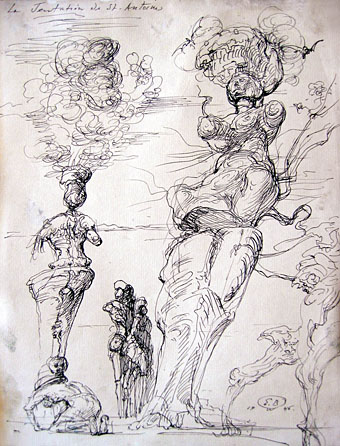
Eugene Berman.
Berman art is scarce on the web so I’ve no idea whether this was his entry or merely a sketch. This is one of at least two drawings he made on the St Anthony theme.

Salvador Dalí.
Easily the most famous of all the pictures. A very memorable image but I can imagine if this had been named the winner its overt eroticism might have caused a problem. This is also a rare depiction for showing the saint directly confronting his temptations; more common is to show him absorbed in prayer or being set upon by demons.
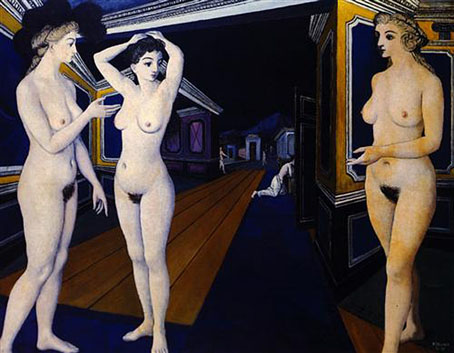
Paul Delvaux.
Not a very good offering from Delvaux, and I’m not sure the film censors would have appreciated all that pubic hair.
Max Ernst.
Ernst’s painting is one of the best of the Fantastic Realism phase his work went through in the mid-1940s. Another one that needs to be seen at large size.
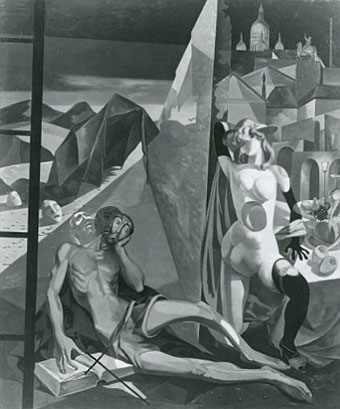
Louis Guglielmi.
Another artist fallen into obscurity, this one was only available in a monochrome photo print.
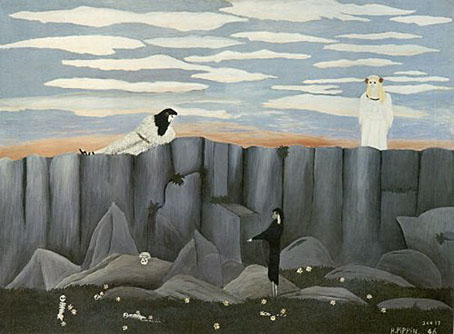
Horace Pippin.
Pippin’s naive style can be very Rousseau-like in his other paintings but that quality isn’t evident here, there’s not much tempting going on.
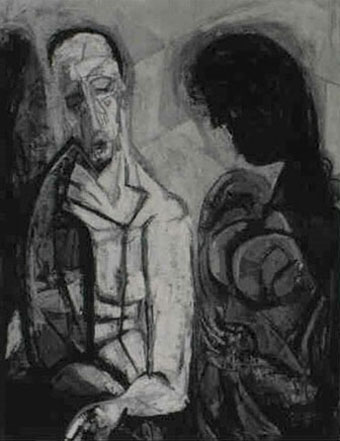
Abraham Rattner.
The title and date are correct but this painting may not be the one submitted for the competition. Either way, this is another that doesn’t really conjure the theme.

Stanley Spencer.
Typical of Spencer to fill the canvas with naked flesh. This one does suit the theme but, once again, all that nudity and overt eroticism might have caused the filmmakers some trouble.

Dorothea Tanning.
Max Ernst and Dorothea Tanning had been living together for several years by this time, and they both took something from Grünewald’s Temptation of St Anthony from the Isenheim Altarpiece. Where Ernst has the saint set upon by demons, Tanning invokes lustful spirits. The creature gnawing Anthony’s arm is a nod to the diseased figure in the corner of the Grünewald painting.
Previously on { feuilleton }
• Max Ernst album covers
• Maximiliana oder die widerrechtliche Ausübung der Astronomie
• Max and Dorothea
• The Secret Life of Edward James
• Dorothea Tanning, 1910–2012
• Dreams That Money Can Buy
• La femme 100 têtes by Eric Duvivier
• Leonora Carrington, 1917–2011
• The real Basil Hallwards

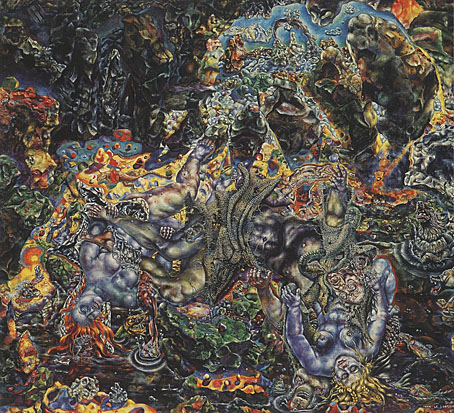

This is both a wonderful idea for a post and a nice piece of art history research, especially when it comes to the obscurer painters Berman, Guglielmi, and Rattner. As for Ivan Albright, I persist in thinking that he is one of the most under-appreciated painters of the 20th Century. His paintings REALLY need to be seen in person, for the sake of both their scale and their astonishing surfaces. Albright canvases are CRUSTY!
I agree about Albright, I’ve still only seen a few of his paintings. I imagine he’s overlooked because he’s yet another artist who doesn’t fit the neat, linear histories that art critics like to build.
You are right, he doesn’t! Albright is a nonpareil. I was lucky to first encounter some of his paintings in person at the Art Institute of Chicago, which is where he studied and which has excellent holdings of his work. The intensity of the paintings knocked me out.